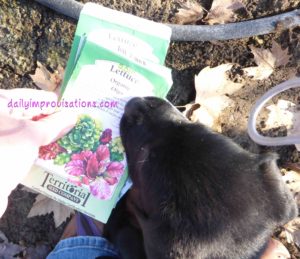Some vegetable crops really require a late winter planting in southwest Idaho to get the best results and full harvest. Peas, spinach, and lettuce, in particular, will begin to sprout nearly as soon as there is a bit of a thaw. They also can’t take the heat, so don’t produce much past June in most cases.
That’s why I was out looking at my garden beds in the first couple of weeks of February. The snow was finally melting off so that I could see large enough patches of dirt. There was also already a volunteer lettuce to remind me about the possibilities!
There are 3 basic options I know of for direct planting late winter/early spring crops:
- Plant seeds in the fall. I’ve had both and success and failure with this. My lettuce that has gone to seed has planted itself and come up in abundance many years, except not last year. I’ve only tried planting peas in the fall once, but unfortunately they did not germinate in the spring. I know others have done it successfully. I think that winter temperatures and moisture in southwest Idaho are too variable to depend on this method. If the mid winter conditions stimulate germination too soon, the seeds will die in the dirt when things get too cold or dry again.
- Cover seeds with a proper depth of potting soil. I already use this method in the later spring to lightly cover very small seeds, such as carrots. The potting soil tends to stay softer, while plain dirt sometimes forms a crust that can make it hard for smaller seeds to break through. I have never used this method for late winter planting. The main potential problem I can see is hard rain washing away potting soil for seeds like peas that need to be planted about 1 inch deep.
- Plant the seeds in the friable soil of raised beds. The soil in my raised beds stays unfrozen longer in the fall/winter and then thaws sooner in the winter/spring than untended soil in much of the yard. It has these qualities because it has been regularly cultured over the years with compost and fresh grass; plus, I don’t walk on it. (click on any photo to enlarge)

What if you didn’t do fall clean up?
All of the above methods will work best if there has been some fall garden clean up. However, if you didn’t get around to that, don’t despair. Be creative with things like cutting off old plants at the soil level if the ground is too frozen to pull them. Also, consider starting some seeds in flats, but planting them out as soon as possible. Just don’t forget to harden them off first.
Once they are planted, hopefully the spring rains will do the rest, but sometimes there might be a long enough dry spell that watering is needed. Also, do the usual to keep the weeds down, because there are some weeds that like to grow this time of year, too! However, planted in their preferred conditions, your crops should grow like weeds also and you will be well rewarded for a little planning.


